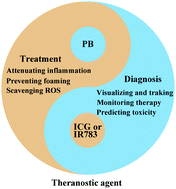Theranostics of atherosclerosis by the indole molecule-templated self-assembly of probucol nanoparticles†
Abstract
Atherosclerosis (AS) is a major cause of cardiovascular diseases, but its effective theranostic measure remains challenging thus far. Macrophages contribute to AS progress in diverse ways such as producing cytokines and reactive oxygen species (ROS), foaming macrophages, and differentiating into pro-inflammatory macrophages. With the aim of constructing a facile and efficacious theranostic system for diagnosis and treatment of AS, a templated self-assembly approach was developed. This strategy involves using indole molecule (indocyanine green (ICG) or IR783) as a template to assemble with probucol (PB) to gain multifunctional nanoparticles (IPNPs or IRPNPs). IPNPs and IRPNPs both showed excellent physicochemical properties, which testified the generality of the indole molecular self-assembly strategy for PB delivery. Besides, the nanoparticles have superior pharmaceutical characteristics including preventing macrophages from differentiating, more efficiently internalizing in inflammatory macrophages, eliminating overproduced ROS, lowering the level of inflammation cytokines, and inhibiting foaming. More importantly, IPNPs displayed effective therapeutic effects in AS model mice when administered via intravenous (i.v.) route. In addition, IPNPs and IRPNPs accumulated more effectively than ICG and IR783 via i.v. injection in the lesion area, and the blood circulation time was extended beyond 24 h. More interestingly, we discovered that the fluorescence imaging ability of IR783 and IRPNPs was more excellent than ICG and IPNPs, respectively. Moreover, a long-term treatment with IPNPs or IRPNPs revealed an excellent safety profile in mice. Accordingly, this self-assembly strategy developed herein is a universal and promising way for the delivery of lipophilic drugs. This study also provides new insights into developing effective theranostic agents for AS.



 Please wait while we load your content...
Please wait while we load your content...